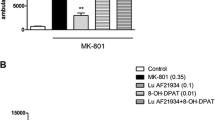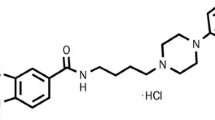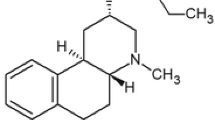Abstract
Ro 22-1319, a novel pyrroloisoquinoline compound, was identified as a potential antipsychotic agent in a rat discrete avoidance procedure that is highly specific for such agents. Results in this test are highly correlated with the clinical potency of all types of antipsychotic agents. The avoidance-blocking potency of Ro 22-1319 (0.7 mg/kg) in this procedure approached that of haloperidol (0.4 mg/kg) and was 7- and 12-times greater than that of chlorpromazine and clozapine, respectively. Ro 22-1319 exhibited similar high potency in other rat and monkey avoidance procedures, rat motor activity, and antagonism of apomorphine emesis in dogs. High potency and antipsychotic-like activity have been demonstrated in monkey EEG and in a in vivo 3H-spiroperidol binding assay. Although studies of amphetamine antagonism in rats indicate antidopaminergic activity at nigrostriatal sites, Ro 22-1319 exhibited relatively weaker cataleptogenic and antistereotypic activity than haloperidol, and had minimal activity in a rat chronic stereotypy model of receptor supersensitivity. This profile suggests that Ro 22-1319 is an efficacious antipsychotic compound, almost as potent as haloperidol, with fewer or less intense extrapyramidal effects and low potential for tardive dyskinesia.
Similar content being viewed by others
References
Baldessarini RJ (1980) Drugs and the treatment of psychiatric disorders. In: Gilman, AG, Goodman, LS, Gilman A (eds) The pharmacological basis of therapeutics. MacMillan, New York, pp 391–447
Barchas JD, Berger PA, Matthysse S Wyatt RJ (1978) The biochemistry of affective disorders and schizophrenia. In: Clarke WG, del Guidice J (eds) Principles of psychopharmacology. Academic, New York pp 105–131
Bautz G, O'Brien RA, Meyers K, Mowles T, Horst WD (1981) Comparison of in vivo and vitro antidopaminergic potencies of a new antipsychotic-like compound (Ro 22-1319). Soc Neurosci Abstr 7:866
Byck R (1975) Drugs and the treatment of psychiatric disorders. In: Goodman LS, Gilman A (eds) The pharmacological basis of therapeutics. MacMillan, New York, pp 152–200
Cook L, Weidley E (1957) Behavioral effects of some psychopharmacological agents. Ann NY Acad Sci 66:740–752
Costall B, Naylor RJ (1975) Detection of neuroleptic properties of clozapine, sulpiride and thioridazine. Psychopharmacology 43: 69–74
Davidson AB, Weidley E (1976) Differential effects of neuroleptic and other psychotropic agents in acquisition of avoidance in rats. Life Sci 18:1279–1284
Davis JM (1974) Dose equivalence of the antipsychotic drugs. J Psychiatr Res 11:65–69
Dunnet CW (1955) A multiple comparison procedure for comparing several treatments with a control. J Am Stat Assoc 50:1096–1121
Fielding S, Lal H (1978) Behavioral actions of neuroleptics. In: Iversen LL, Iverson SD, Snyder SH (eds) Handbook of psychopharmacology, vol 10. Plenum, New York, pp 91–128
Heise GA, Boff E (1962) Continuous avoidance as a base-line for measuring behavioral effects of drugs. Psychopharmacologia 3:264–282
Hollister LE (1976) Psychiatric disorders. In: Avery GS (ed) Drug treatment: Principles and practice of clinical pharmacology and therapeutics. Publishing Sciences Group, Acton MA, pp 796–844
Kebabian JW, Calne DB (1979) Multiple rectors for dopamine. Nature 277:93–96
Klein DF, Davis JM (1969) Diagnosis and drug treatment of psychiatric disorders. Williams and Wilkins, Baltimore, pp 52–138
Olson GL, Cheung HC, Morgan KD, Blount JF, Todaro L, Berger L, Davidson AB, Boff E (1981) A dopamine receptor model and its application in the design of a new class of rigid pyrrolo [2,3-g]-isoquinoline antipsychotics. J Med Chem 24:1026–1034
Simpson GM, Lee JH (1978) A ten-year review of antipsychotics. In: Lipton MA, DiMascio A, Killam KF (eds) Psychopharmacology: A generation of progress. Raven, New York, pp 1131–1137
Sokoloff P, Martres MP, Schwartz JC (1980) 3H-Apomorphine labels both dopamine postsynaptic receptors and autoreceptors. Nature 288:283–286
Tedeschi DH, Fowler PJ, Crowley WH, Pauls JF, Eby RZ, Fellows EJ (1964) Effects of centrally acting drugs on confirment motor activity. J Pharmacol Sci 53:1046–1050
Ungerstedt U (1971) Striatal dopamine release after amphetamine or nerve degeneration revealed by rotational behavior. Acta Physiol Scand (Suppl) 367:69–93
Author information
Authors and Affiliations
Rights and permissions
About this article
Cite this article
Davidson, A.B., Boff, E., MacNeil, D.A. et al. Pharmacological effects of Ro 22-1319: A new antipsychotic agent. Psychopharmacology 79, 32–39 (1983). https://doi.org/10.1007/BF00433013
Received:
Accepted:
Issue Date:
DOI: https://doi.org/10.1007/BF00433013




